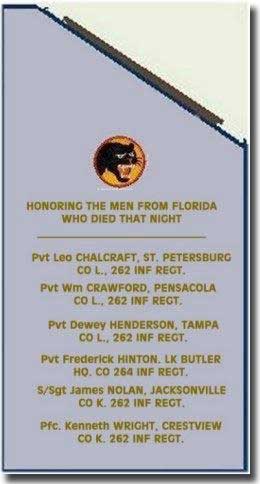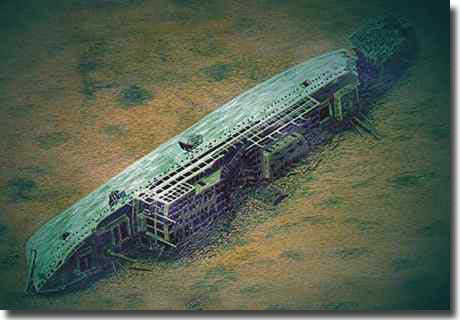|
Belgian Trooper SS Leopoldville, sunk by U-486. Christmas eve 1944, and 783 US troops die
Introduction. But her time was nigh! This was to be her last tragic voyage.
262nd. and 264th. Regiments part of the 66th. US Infantry Division. Now came the order to embark at 0200,( 2 AM ) another troop ship Cheshire was also involved in loading troops. But there seemed to be no plan or structure to this embarkation, the two Regiments were mixed up, one might expect that troops from one company would stay together, not so. As troops arrived, they loaded randomly, chaos reigned supreme. Much later, after Leopoldville was torpedoed, this haphazard loading pattern compounded the problem, who were missing? who might be in Cheshire? no records, no one knew the answers. Leopoldville to date. As usual, troops were crowded onto benches fitted in the converted cargo hold, another 18 hours would see this voyage all over. The young soldiers mostly around the age of 21, crowded the rails to get their last glimpse of England, as the ship pulled away from Southampton docks at 0900 ( 9 AM.) It was the 24th. of December 1944, with Christmas eve but a few hours hence. They little dreamed of the disaster soon to unfold. Boat Drill ordered. Ships assume steaming formation. The Escort Commander sailing in Brilliant ordered the formation to zigzag, never before had Leopoldville been ordered to zigzag on any of her previous crossings, but with enemy submarines operating in the vicinity, it seemed a prudent order. Now at 1430 ( 2.40 PM ) Brilliant reported an ASDIC contact, the two troopers sounded off Action Stations, the destroyers rushed off to drop depth charges, but after 15 minutes the alarm was called off, only to be reinstated again at 1500 ( 3 PM. ) But in another 10 minutes the previous formation was resumed and the group pressed on at 13 knots.
U-486 lurking off Cherbourg. Leopoldville obliged by coming into range about 1754 ( 5.54 PM ) when a torpedo was fired, and the CO took his boat deep to await the inevitable depth charge attack. His torpedo ran truly, smacking into Number 4 hold on the starboard side of the troopship. Compartments E4, F4, and G4 all flooded, the access ladders to the upper decks were in general destroyed, of the 300 troops in these areas, but a few managed to make it to the safety of higher decks. Contradictory Communications. Those in authority did not take charge of the situation, the ship was drifting towards a minefield, and at 1816 ( 6. 16 PM ) Brilliant ordered the torpedoed ship to let go an anchor. Now at 1825 ( 6.25 PM ) the Captain ordered all but essential crew members to abandon ship, but it was certainly not apparent that the ship was sinking. But the sight of the crew taking to the lifeboats, lowering them, and pulling away from the stricken vessel did nothing to instil confidence in all the US troops crowded on deck. Brilliant found that the US troops ashore in Cherbourg only some 5 miles away, were operating their radio on a different frequency from the British, and the destroyer had to get in touch with Portsmouth authorities to ask them to relay the call for help from ashore in Cherbourg. What a communications mess, not the first time in WW2 that Allied forces could not speak to each other in a time of crisis, because of some different frequency, operating procedure, or lack of the necessary equipment. In 1942, at the Battle of Savo Island, in my cruiser HMAS Canberra, we did not receive a warning of " Enemy Ships Entering Harbour" sent by USS Patterson on her Talk Between Ships phone, simply because we did not carry that equipment. If it were not so serious it would be laughable! Here we are two years on, and communication stuffups still around. It took over a precious hour for the message from Brilliant via Portsmouth to get to Cherbourg by telephone. One can but assume and hope the German Armed forces suffered from similar misshaps in their communications set up. No convoy ships tried to raise Cherbourg by means of a signalling lamp and morse code, but Cherbourg tried to reach the convoy vessels by such means, but no one was keeping a watch for such a message, all to no avail. At long last at 1825, ( 6. 25 PM ) Brilliant signalled: " Leopoldville hit, need assistance. " When asked what kind of assistance was required, no response was forthcoming, its all just unbelieveable, no lookout kept, no reply to serious questions, no proper description initially of what help was needed. Some heads should roll in due course. Christmas Eve. At 1825 ( 6. 25 PM ) Brilliant was taken alongside Leopoldville, some lifeboats still turned out on their davits were a problem, and the two ships coming together in the lively sea running crushed them like matchwood. Now the ships drifted apart, and hundreds of young soldiers tried to leap the gap between both ships to safety, alas some did not make it, and were crushed as the two ships pounded together once more. Back in 1942, when US destroyer Blue came alongside the crippled, listing, burning Canberra, I too was faced with that dilemma, its a matter of some judgement, just when you decide to bridge the gap and JUMP, when the two ships are apart, but will soon be grinding against each other when the gap is closed again. A sense of relief flooded over me after I had leapt off the deck of Canberra and landed safely upon Blue's iron deck some distance below. At 1920 ( 7. 20 PM ) crowded with an extra 500 souls, Brilliant pulled away from Leopoldville, and finally the first rescue craft from Cherbourg were on their way. The rest of the escort were still chasing after U-486, intent on keeping her submerged. John Pringle, CO of Brilliant and Convoy Commander, considered that the rescue craft would collect the 1,200 or so troops still on board the troopship, this judgement was later to be questioned. Explosions in Leopoldville.
More victims of U-486. Final Fate of U-486. An Allied Wall of Silence.
In 1996 the British released some of their documents on this incident, but not all. Two books, The Night Before Christmas by Jacquin Sanders. Buccaneer Books Inc. New York 1993. SS Leopoldville Disaster By Allan Anrade. Tern Book Company. New York. 1997, have helped lift the vale on this tragic story of the sea in WW2. Conclusion. Relatives of service personnel who die in such incidents deserve to know the true facts, and not be fobbed off by lies and half truths. As Clive Cussler aptly described the Leopoldville sinking " Forgotten by many, remembered by few."
|





